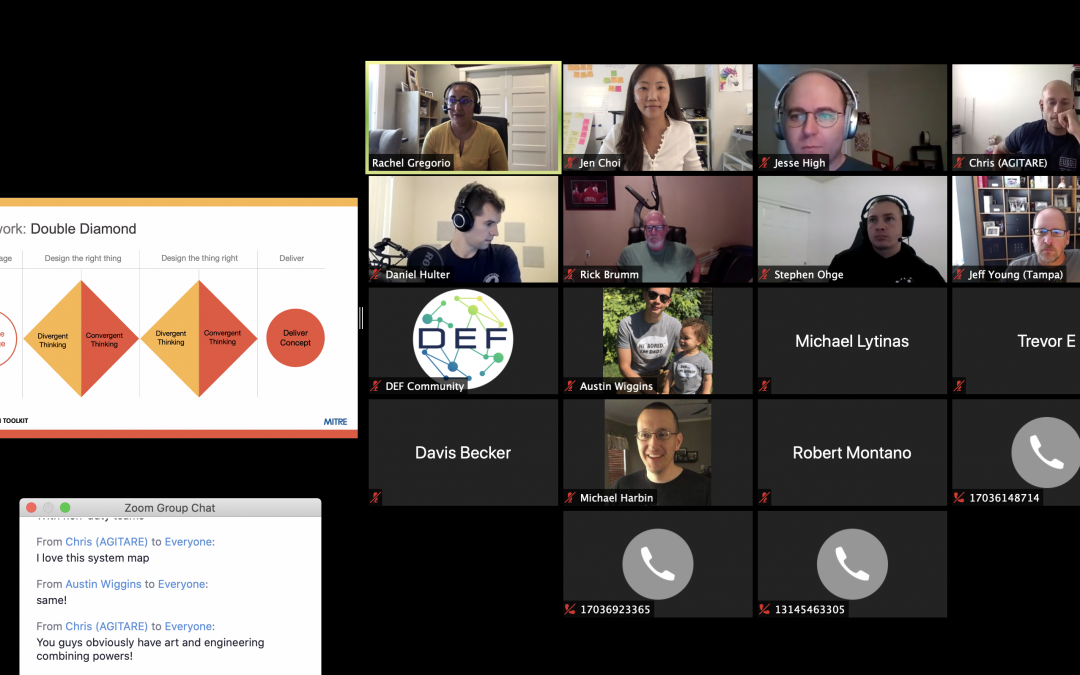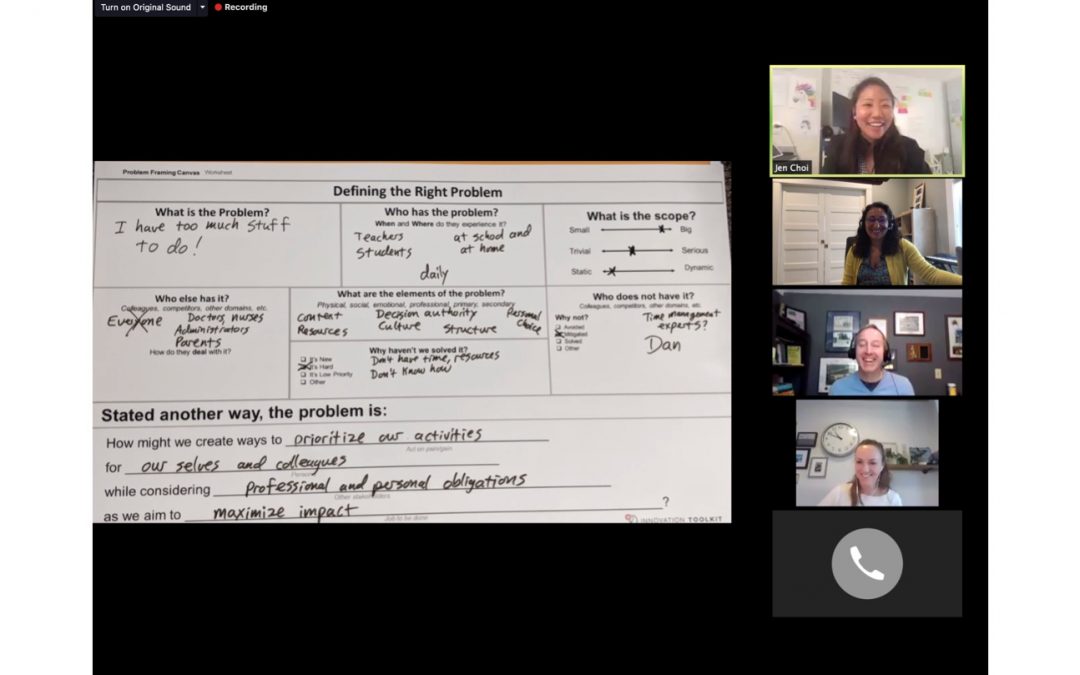Featured Story
Use this area to highlight news, Announcements, and Featured Items by using the blog feature
Use this area to highlight news, Announcements, and Featured Items by using the blog feature
Use this area to highlight news, Announcements, and Featured Items by using the blog feature

The Defense Entrepreneurs Forum (DEF)’s mission is to promote a culture of innovation in the national security community, and Project Agitare is a group of DEF Facilitators who are passionate about putting innovation, design, and discovery skills, tools & methods into the hands of individuals across the Defense community.
When their founder, Air Force Tech. Sgt. Daniel Hulter, invited Team Toolkit to present in a training workshop, it was a no brainer for Team Toolkit to connect with fellow co-conspirators for innovation! Jen Choi and Rachel Gregorio introduced two MITRE-unique tools, the Premortem and Culture Change Canvas, that every organization should keep in their back pocket. Check out the full recording here!
Project Agitare aims to further the vision to enable innovation in the Department of Defense, by introducing a type of social technology that they call facilitated discovery. If you’d like to learn more or get involved, check out Project Agitare’s page on the DEF site.
(PLAIN LANGUAGE DISCLAIMER: we’re providing the link so you can learn more about Agitare, but it’s not an official MITRE endorsement or anything like that)

Bridging Innovation frequently partners with MITRE’s Innovation Toolkit (ITK) team – also known as “Team Toolkit” – to train our employees, government sponsors, and startups learn how to be innovative and jumpstart the innovation process. Using the user-centered methods in the ITK will help teams to ask and answer the right questions, build consensus around the problem they’re trying to solve, and design the right thing.
The ITK is a curated collection of tools to empower us to think and work more like innovators. The Toolkit is made up of 25 lightweight, low-cost, high-impact methods and templates that get everyone innovating, regardless of their domain. All tools come with a template and description of how to use it on the website. The tools are organized into use cases on the ITK website.
In July, Rachel Gregorio, from Team Toolkit, introduced the ITK to the MassChallenge Texas cohort. She provided the startups with some suggested tools that they can apply to some typical use cases, such as using Premortem to plan ahead and assess risks, Rose, Bud, Thorn to capture rapid feedback from users, and Mission Vision Canvas to define where their company is going.
Also in July, Team Toolkit hosted a virtual Challenge Statement training for members of the Banshee program, a 2-week innovation training program run by Hanscom Air Force Base and MassChallenge for Air Force and Army acquisition programs. Using 3 tools from the ITK, Jen Choi, Rachel Gregorio, Marissa McCoy, and Dan Ward led 60 program participants through a tool chain – where the output of one tool leads to the input of the next tool – to develop challenge statements releasable and generalized for industry.
Team Toolkit started by explaining the Lotus Blossom, a divergent ideation tool, before converging around their favorite ideas using the Stormdraining tool. Next, the participants walked through the Problem Framing tool to reframe and refine their problem statement. Taking the final outputs from the tool chain, they were encouraged to further generalize the statement, line-by-line, to ensure it removed acronyms, jargon, and specificity to mission.
Participants in the Banshee program learned powerful methodologies and easy to use tools to shape their problems and solution needs in clear and concise language without being prescriptive in the implementation. This approach opens the door for finding game changing innovative solutions
If you’re interested in working with Team Toolkit, feel free to reach out to the team via our Contact form and subscribe to their newsletter to stay up-to-date on all things innovation!

Persona is a tool we use to describe a semi-fictional ideal customer or user of your product or service. The tool lives under “Understand User” category and serves as a vital way to understand or empathize with their perspective, opinion, or point of view.
Personas help a project team understand their users’ needs, motivations, limitations, and capabilities, acting as a focal point and reminder throughout the project, ensuring the final product is something a human being would actually need or want. Personas accelerate the process of developing and validating solutions, are a useful component of thought-experiments, and help increase the clarity and realism of the project team’s pitches and presentations.
Envisioning a persona can be challenging, especially when starting with a blank sheet of paper. What do they like? What do they do? What are their responsibilities? What are their values? Ideally, you want your personas to be built off existing user research to help answer these questions. But what if you don’t have existing users? Sometimes it’s easier and more impactful to start by outlining an anti-persona – or PersNOna – that you want to target. Identifying what falls out of scope can be just as important as identifying what falls into scope. Using reverse thinking, this exercise clarifies, refines, and builds consensus among your team.
We’re no strangers to reverse thinking or brainstorming here at Innovation Toolkit. If you’re familiar with our Premortem tool, you know that through defining failure, we inversely define success. Sometimes it’s easier to think negatively about all the things that could go wrong and where we may misstep, than what we actually need to do to succeed.
Oftentimes, thinking about the reverse can be freeing and allow ideas to flow more openly than solution-oriented brainstorming, removing the pressure to be “right” and encouraging failure. Once you’ve brainstormed all of the ideas for failure, you reverse them into solutions. Reverse brainstorming is a good technique when it is difficult to identify solutions to the problem directly. It could be used in standard solution brainstorming, too (challenge: fill out a Lotus Blossom with anti-ideas!).
You may want to create a PersNOna for several reasons:
Sometimes it’s easier to start with the “definitely nots” than the “definitely’s.” That was the case when we were discussing adding new members to Team Toolkit. We couldn’t quite put our finger on the qualities of someone we would want to join the team, but it was much easier to write down what we did NOT want. Some examples of the “thanks, but no thanks” category were ego driven, fixed mindset, did not want to collaborate or learn, and traditional/set in their ways. The team got passionate about this discussion, especially because we all agreed we wanted to maintain the cultural attributes of the team when adding training new folks.
Have you put off creating a persona or solving a problem because landing on the “right” solution felt too daunting? We encourage you to try flipping the script and flexing your reverse thinking muscles to define the “nope’s” before getting to the, “Yup, that’s it!” We all deserve to be off the hook for thinking of the “right” thing every now and then, we can finally get to a truly innovative solution – something different that makes a difference.